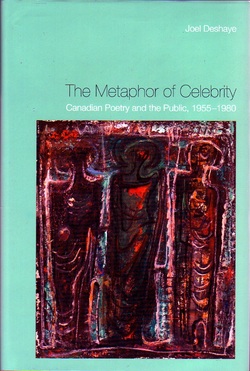
In “The Era of Celebrity in Canadian Poetry,” the second chapter of his The Metaphor of Celebrity: Canadian Poetry and the Public, 1955-1980, Joel Deshaye declares that 1955-1980 was Canadian poetry’s “era of celebrity.” He doesn’t find many celebrity poets, however. He proposes only four possibles: Irving Layton, Leonard Cohen, Michael Ondaatje and Gwendolyn MacEwen, the latter whom he qualifies as “a celebrity of low degree compared to some of her contemporaries” (200). Ondaatje also seems a questionable celebrity in this period by the criteria that Deshaye uses, although he’s undoubtedly had later moments as an international novelist-celebrity. Deshaye’s readers could well wonder how many celebrities it should take to make an “era.” Even Deshaye at times in this chapter seems unimpressed by the degree of celebrity he can establish for any of his poets, at one point writing that he hopes only to recognize “the real, though limited, success of this group of poets beyond and in the literary field ordinarily assumed to be incapable of supporting stardom” (44).
Certainly Deshaye appears to have no interest in glamourizing his 1955-80 era. He is, in fact, often usefully cynical about the ambitions of the four writers and the means they used to achieve them, calling their claims to spiritual insight “religious pretence” (11) and the textual enactments of masculinity by the male poets unconscious “parody” and “grandstanding” (7). He implies that their themes of personal freedom – frequent in Layton – may have been a grasping at an illusion, and that their self-portrayals as sacrificing themselves for their art were mere posturing in hope of attracting empathetic fans.
Most of the poets in this study wrote about themselves as if they were more widely recognized
than they were in reality, or wrote as if they were other celebrities of higher degree. I call this
self-aggrandizement "grandstanding" to suggest that their self-promotion and identity formation
depend on metaphor .... (15)
Sacrificing “themselves” is a rather problematic concept for Deshaye because in his various comments on identity formation (which he evidently understands through Diana Fuss’s theories of metaphoric substitution) he shows little
What he does bravely do is attempt to distinguish, however arbitrarily, between celebrity and fame. Fame, he argues, following the OED, is “reputation derived from great achievements," whereas a celebrity – here he follows Daniel Boorstin – is “a person who is known for his well-knownness.” He thus has to argue that Warhol’s concept of “twenty minutes of fame” was actually twenty minutes of celebrity (31). The result is that he is under no obligation to argue that any of his four poets have great achievements – only that they managed to become somewhat well-known. Their inclusion in his book is not necessarily a mark of their literary achievement; it’s a mark of their public attempts to be known (and read) for being well-known, and of the possibility that they may themselves have confused celebrity with both fame and achievement.
He outlines his criteria for being a Canadian celebrity poet during 1955-80 in his opening two chapters. The poet must become a celebrity while writing mostly poetry – this disqualifies Margaret Atwood, whom he judges became a celebrity through the publication of Survival, Surfacing and her next few novels. He or she must have some “presence” on radio and television and “frequent” appearances as author or topic in major Canadian magazines and in Toronto’s Globe and Mail newspaper. He does not suggest threshold numbers. For inclusion in this study, the poet must also thematize the experience of celebrity in poetry – a criterion which again disqualifies Atwood, whom he sees as thematizing it primarily in prose fiction, and unambiguously disqualifies Al Purdy, he believes, who in terms of his degree of celebrity by Dehaye’s measures ranks third after Layton and Cohen. These first two chapters are less clearly written than the others, with numerous repetitions of their principal claims, and often puzzling syntax – possibly an indication that the author feared that his arguments would be difficult to accept. To support them, he appends charts of the appearances during his “era” of Layton, Cohen, Ondaatje and MacEwen on CBC television, CBC radio, in the Globe and Mail, and in the Canadian Periodical Index. These charts would have been more informative and potentially convincing had they contained numbers for the top ten or so poets of the period, including Atwood and Purdy. Instead they show only which of his chosen four was more or less ‘celebrated’ in a given year than the other three.
Another limitation which his criteria make clear is that to a great extent his book is not about celebrity in Canadian poetry: it is about the era of celebrity in Toronto poetry. Three of his four poets were residents of Toronto in most if not all of the 1955-1980 period; Cohen lived numerous places – often outside of Canada – but the publisher and energetic promoter of his eight books during the period was Toronto’s McClelland & Stewart. CBC radio, CBC television, the Globe and Mail, and the popular magazines – Maclean’s, Saturday Night, and Chatelaine – that Deshaye relies on for his celebrity criteria were all headquartered in Toronto. Five of the seven literary magazines that he cites – Canadian Forum, Tamarack Review, Queen’s Quarterly, Alphabet, Canadian Poetry, Delta and Fiddlehead were published in or near Toronto. Perhaps unwittingly, Deshaye has written a book that both documents and repeats the Toronto-centrism of writing in Canada in the period it considers, a city in which Layton, Ondaatje and MacEwen could hand-deliver their manuscripts to their publishers, have local phone contact with editors and producers, socialize with them, and travel by cab to radio and TV studios. These were material factors which made it much easier for a Toronto writer to be a ‘celebrity’ – i.e. “a real, but limited, success” – than one living in Calgary or St. John.
FD
 RSS Feed
RSS Feed